The national flower of Ireland is the shamrock which, interestingly, is not a flower in the truest sense. But, given how connected the shamrock is with Irish culture, we won’t quibble over details. Beyond the shamrock, though, Ireland is home to some stunning (actual) flowers. Here are nine beautiful blooms native to the Emerald Isle.

The shamrock is the national flower of Ireland.
©Rejmann-2/Shutterstock.com
1. Cowslip (Primula veris)
The cowslip is among the most prized and beautiful native wildflowers in Ireland. So much so that the flower was threatened in Northern Ireland due to over-picking, coupled with intensive farming practices. In 1985, the Wildlife Order offered special protection to the cowslip. It is now making a slow comeback in the Northern Ireland landscape.
The cowslip features a rosette of green leaves and bell-like yellow flower clusters atop its upright stems. The flowers bloom in April and May with five petals each.
The name “cowslip” is a distorted pronunciation of “cow slop.” This came from the flower’s propensity to grow in meadows where cattle graze. It also has several other colloquial and folk names, such as “St. Peter’s keys,” “bunch of keys,” and “keys of heaven.” Folklore states that cowslips grew where St. Peter dropped the Key of Earth.

The bright yellow cowslip flowers are now a protected species.
©nnattalli/Shutterstock.com
2. Eyebright (Euphrasia spp.)
More than ten species of eyebrights grow in Ireland, many of which look similar to one another, making it hard to tell them apart. They also hybridize, which makes identification even more difficult. But all eyebrights are sure to make the eyes of wildflower lovers sparkle!
These wildflowers are semi-parasitical, meaning they attach to another plant and derive a portion of their nutrients from that host. All species of eyebright have dual-lipped flowers with purple stripes and a bright yellow spot in the throat. Eyebrights are summer flowers, blooming from June- September. In Northern Ireland, they grow on rocky cliffs as well as in limestone meadows and grasslands. They also grow on the sand dunes of the west coast.
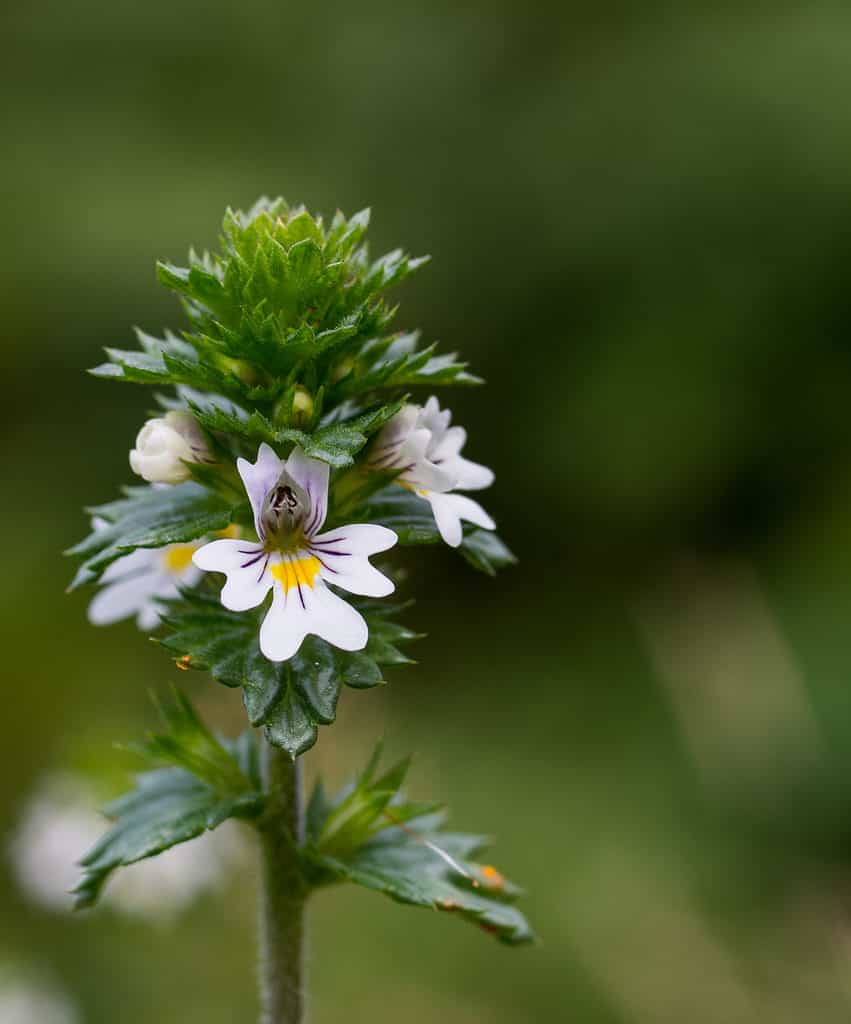
Eyebrights feature dual-lipped flowers with purple strips and yellow spots.
©Pavel_Voitukovic/Shutterstock.com
3. Sea Aster (Tripolium pannonicum)
This wildflower may look delicate, but its appearance is deceiving. This tough, durable plant thrives in nutrient-poor soil, often growing on rocky cliffs. It also thrives along the coast, near estuaries, and in salt marshes. It is tolerant of salt spray and can even survive partial immersion in saltwater. The lovely flower is as tough as they come!
The sea aster blooms from early summer to mid-autumn. It can grow upwards of three feet tall, producing clusters of mauve flowers with a bright yellow center. The daisy-like blooms are magnets for pollinators such as butterflies.
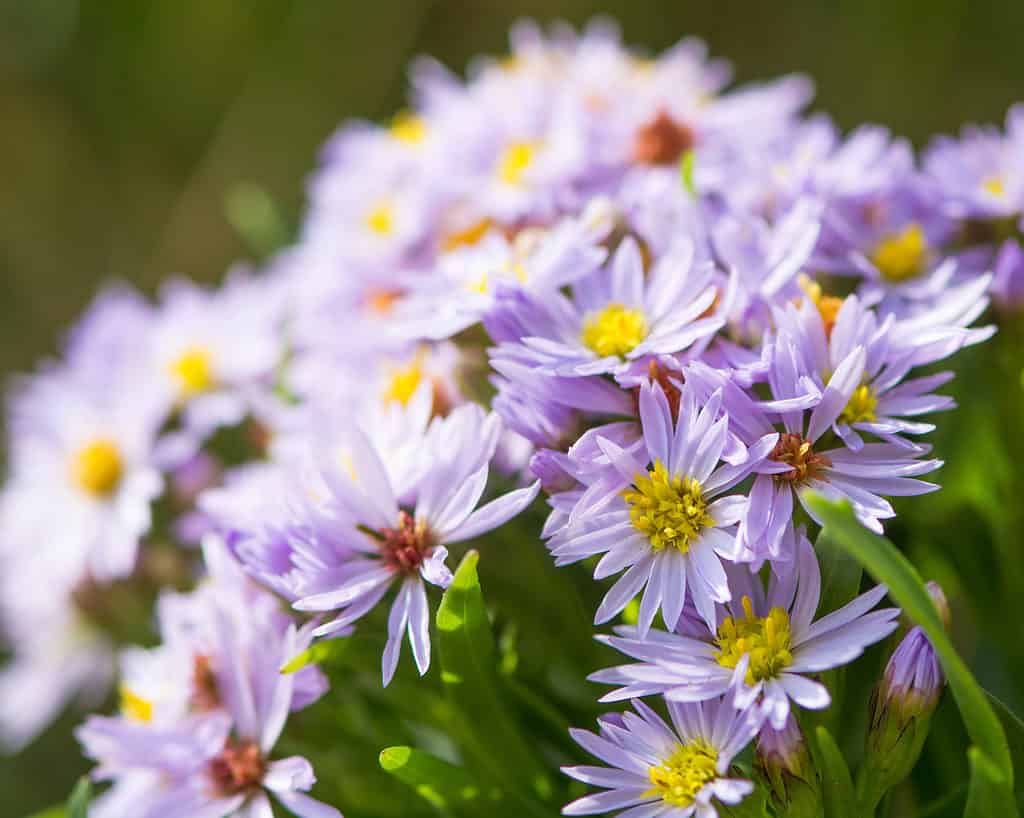
The mauve flowers of the sea aster bloom all summer long.
©IanRedding/Shutterstock.com
4. Common Centaury (Centaurium erythraea)
This low-growing biennial grows on sand dunes, as well as in fields, rocky cliffs, woodland edges, and open scrubland.
Blooming from May to September, the common centaury produces clusters of lovely pink, five-petaled flowers. The flowers only open in the early morning sun, though. They close up during the afternoon, so you’vyou’veto get out early to enjoy these beauties. The flowers will also remain closed on damp or overcast days.
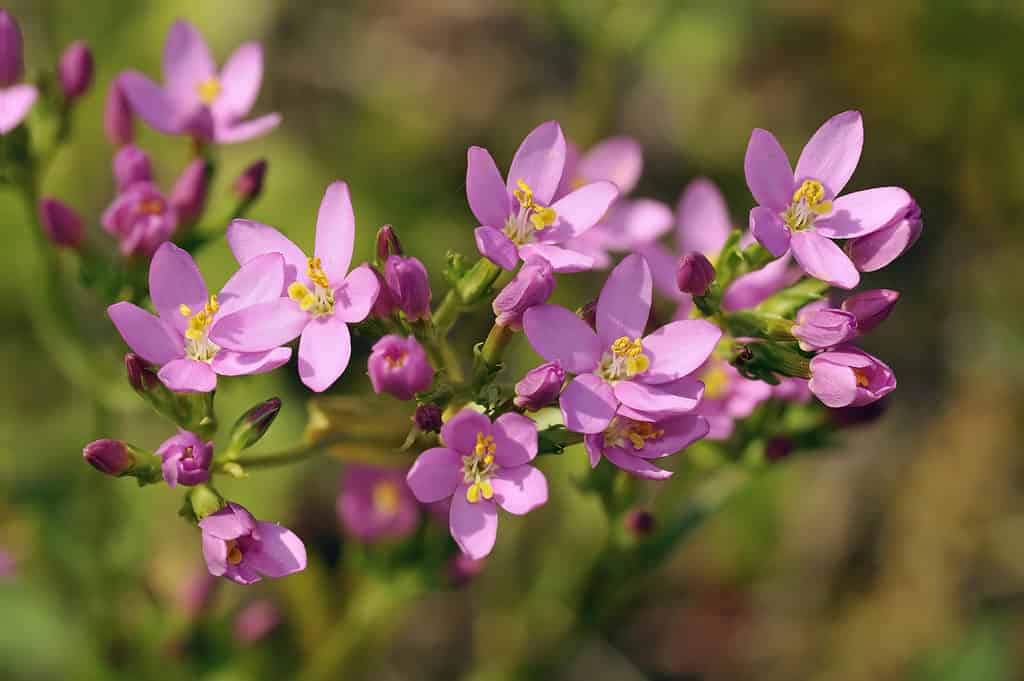
The pink blooms of the common centaury only open in the morning sun.
©Martin Fowler/Shutterstock.com
5. Bog Rosemary (Andromeda polifolia)
The bog rosemary may share a name with an herb in your kitchen cupboard, but that’that’se the similarities end. The bog rosemary plant is highly toxic.
As the name suggests, these evergreen shrubs grow in the bogs of the Irish midlands. Several of these shrubs will often grow together, forming a clump.
Unique small, bell-shaped flowers bloom on these shrubs in May. The flowers are initially bright pink or white and appear in a curved umbel at the tip of the branches. An umbel is a cluster of flowers made up of several short stalks that spread from a single point, resembling the ribs of an umbrella.
As spring turns to summer, the blooms of the bog rosemary will lose their brightness and take on more pale hues for the remainder of the blooming season, which ends in September.
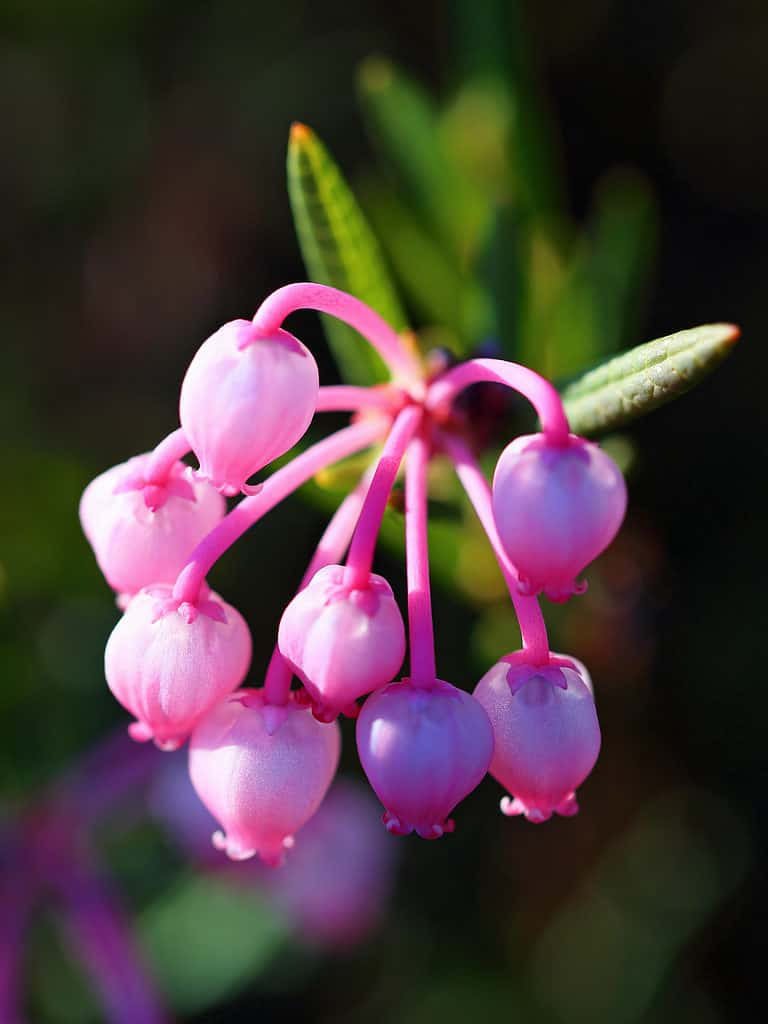
The pink flowers of the bog rosemary plant grow in a curved umbel.
©Grigorii Pisotsckii/Shutterstock.com
6. Spring Squill (Scilla verna)
All squills used to be included in the Lily family (Liliaceae). DNA analysis has resulted in their reclassification. Squills, including the spring squill, are now part of the Asparagus family (Asparagaceae).
First recorded in the wild in 1641 in Dublin, the spring squill is a salt-tolerant wildflower that grows mainly along Ireland’s eastern coast. The six-petaled lilac-blue blooms dot Ireland’s coasts and grasslands, where they thrive in the wind-driven sea spray.
The blooming season is short-lived, though. This small perennial bulbous plant only blooms from April-May. While the blooms don’t last long, they are much beloved. The spring squill was voted thedon’tty flower of County Down in 2007.
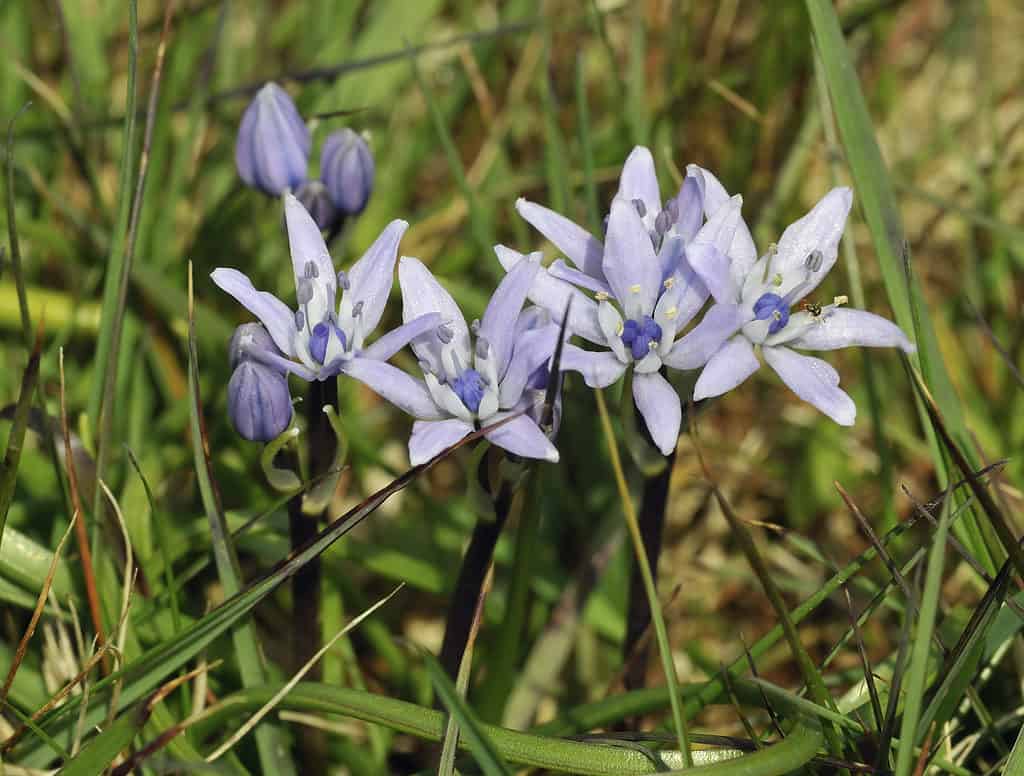
The lilac-blue spring squill is the county flower of County Down.
©Martin Fowler/Shutterstock.com
7. Buttercup (Ranunculus acris)
Various buttercups native to Ireland include the “creeping buttercup,” “meadow buttercup” (also known as the “tall buttercup”), and “bulbous buttercup.”
Whatever the variety, though, these wildflowers proliferate in Irish meadows and countrysides. In fact, buttercups are so pervasive and fast-spreading that some gardeners view them less as wildflowers and more as bothersome weeds. But it’s hard not to be delighted when these bright, sunny flowerit’sorn the landscape.
The buttercup features bright yellow five-petaled flowers with five green sepals underneath. These small perennial wildflowers have a rather long blooming season, lasting from April-October.
The buttercup name comes from the tiny cup-shaped scales at the base of the petals. This cup holds the nectar that draws pollinators. Hence, it is the flower’s “buttercup.”
There’s also an old Irish tradition that has been passed down for generations. Young children will place a buttercup flower under another child’s chin. If the yellow is reflected back to the chin, that child is said to have a great love for butter!
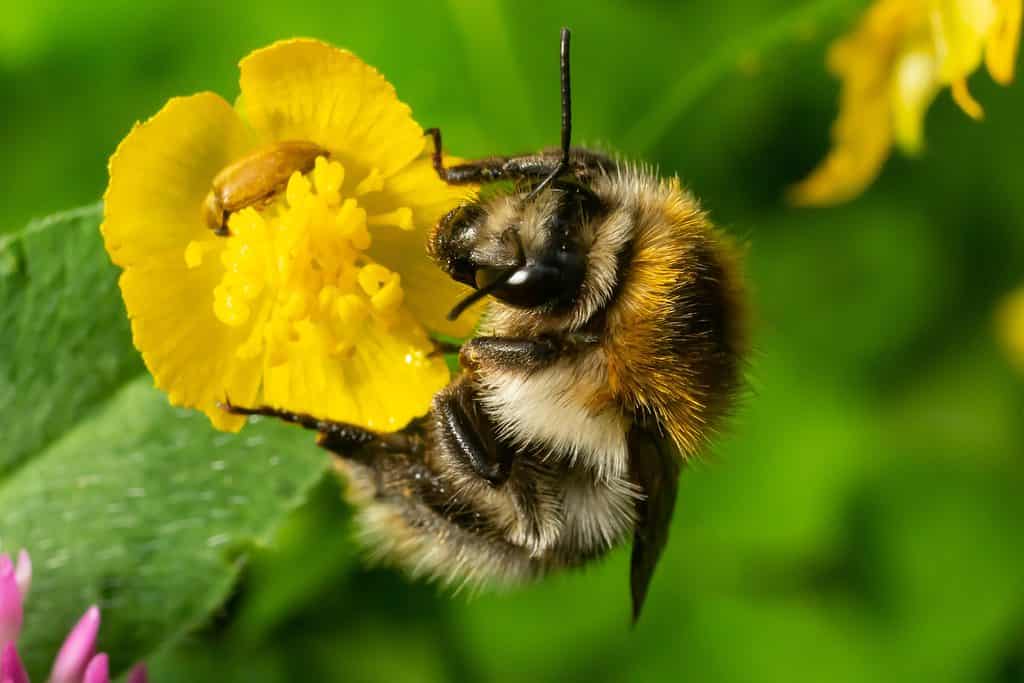
Pollinators, like this bee, are drawn to the buttercup.
©olko1975/Shutterstock.com
8. Marsh cinquefoil (Comarum palustre)
A flower with many names, the marsh cinquefoil is also known as “purple marshlocks,” “swamp cinquefoil,” “bog strawberry,” and “purple marshwort.” Whatever name you prefer, this wetland wildflower is a true beauty.
The roots of the marsh cinquefoil enjoy growing in Ireland’s marshes, ponds, and lakes. The star-shaped flowers of this perennial display five narrowly pointed petals that are deep maroon-red, backed by five pale purple sepals that are longer and broader than the petals.
Cinquefoils are members of the Rose family (Rosaceae). Most feature yellow flowers, but the marsh cinquefoil is unique with its magenta-colored blossoms.
Blooming from May-July, pollinators such as bees and butterflies highly praise these flowers.
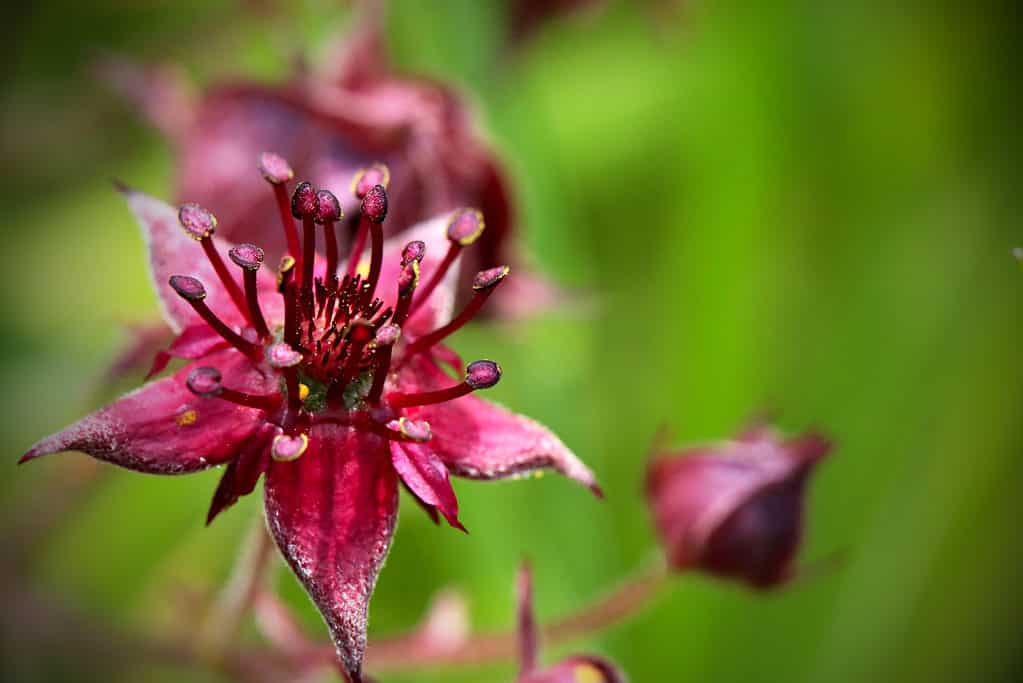
The marsh cinquefoil is the only cinquefoil with magenta petals.
©Jitka Sterbova/Shutterstock.com
9. Primrose (Primula vulgaris)
It’s also known as the “English primrose,” but this wildflower is Irish through and through. Primroses dot Ireland from March-May.
The beautiful lemon-yellow blooms are ubiquitous, growing everywhere from grassy roadsides to wooded regions to residential gardens. The flower and plant are also edible, with a lettuce-like flavor.
This unassuming hardy perennial was considered sacred in ancient Celtic culture: placing primroses on your doorstep would invite fairies to bless your home. The Druids often carried primroses during their Celtic rituals as protection from evil. They also used them for medicinal purposes, treating all sorts of pain, from muscle aches to toothaches.
While we’re unsure about warding off evil or curing a toothache, the delightful yellow primrose flowers can lift our spirits on a spring day!

The lemon-yellow blooms of the primrose appear throughout Ireland.
©tony mills/Shutterstock.com
Final Thoughts
Far be it from us to knock the iconic shamrock, but that’s just the beginning. The flora of Ireland is varied and expansive, growing from soggy marshes to grassy meathat’so sea cliffs. The beauty of Ireland’s native flowers is something to behold!

Native Irish flowers, such as this cowslip, are a great reason tIreland’sa hike!
©by Paul/Shutterstock.com
The photo featured at the top of this post is © Eugen B/Shutterstock.com
Thank you for reading! Have some feedback for us? Contact the AZ Animals editorial team.






